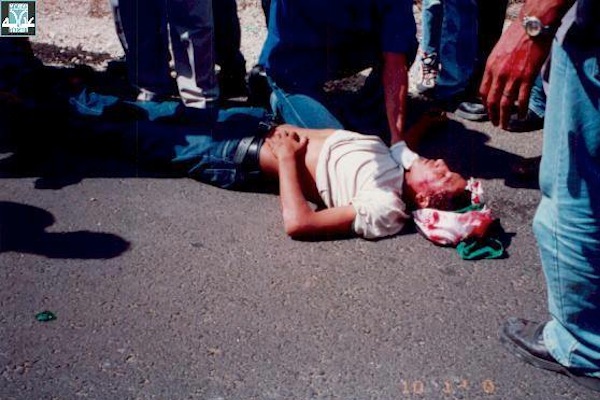Fifteen years after Israeli police murdered 13 unarmed Palestinian citizens of Israel, the sister of one of those young men asks whether the dominant national symbolism of martyrdom must trump the humanitarian aims and face of Palestinian liberation.
By Siwar Hasan-Aslih

If you ask Palestinians who lived through the the events of October 2000 what exactly happened and why, you would probably hear a range of answers reflecting a number of worldviews. Some might point to the martyrdom of Muhammad al Dura, others to Ariel Sharon’s violation of the sanctity of Al-Aqsa Mosque.
The first reflects a human — or humanitarian — perspective while the other points to religious and spiritual factors. Whatever the reason, there is no doubt that the events of October 2000 carried diverse messages for Palestinian society and came in varied shapes, whether in the goals of the Palestinian resistance, or the symbolism of the struggle.
Sharon’s visit to Al-Aqsa Mosque — surrounded by hundreds of Israeli police officers — at the end of September 2000 national rage on the Palestinians street from the Gaza Strip to the West Bank, and also reached Palestinians inside Israel. That rage, of course, was rooted in the occupation, racial discrimination and the failure of Oslo peace process. Despite all those other factors, however, it was the call to protect holy sites that pushed the mass demonstrations to start.
As a result, it was named the “Jerusalem Ignition” and later assigned religious character. But it was not only religious, Al-Aqsa and Al-Quds (Jerusalem) also reflect symbols in the discourse of Palestinian resistance.
Palestinians, like most societies, use symbols to help one understand one’s meaning in relation to the world and the one’s attachment to his or her culture. Symbols also have functional roles. They are tools of communication and help create collective identity, enabling the formation of society.
The Palestinian national experience has many symbols that are drawn from our reality of occupation, symbols that enable Palestinians to express their feelings and values of resistance. One of the most dominant symbols of October 2000 was the martyr. In the Palestinian context, a martyr refers to somebody who dies or sacrifices his life for the cause of liberty and justice for the Palestinian people, including both those who are murdered by the occupation and those who die fighting it.
The societal rituals and mythology surrounding martyrdom create a certain psychological atmosphere. But how does that affect the way Palestinian discourse treats more humanitarian symbols? Symbols of life?
The Palestinian national discourse is greatly influenced by our experience of death, but also by our resilience and survival. The result is that in our internal, national discourse, the tragic nature of reality often times trumps our humanitarian face. In our march for liberation we have created a discourse whose aims are measured in self sacrifice. The symbols of resistance and freedom are then used to call for more sacrifices of martyrs while eliminating the true, human, cultural and mythological face of martyrdom.
Martyrs are not heroes because they died, but rather because their humanity is manifested in their dreams, their connection to the land, their resilience in holding on to life in the face of oppression and occupation. The martyrs were not born to take part in a project of martyrdom, they were born to take part in the project called life. They sanctify life by sacrificing themselves for it.
Today, 15 years after the events of October 2000, we still discuss our martyrs in numbers and not in their human message for life. We commemorate them and yet we still imbue the hearts and minds of our youth with the ideas the sacrificing oneself and heroic descriptions of martyrdom.
Nobody exemplifies that idea more than the martyrs of October 2000, when Israeli police murdered 13 unarmed Arab protesters in northern Israel. How many Palestinian youths know the human face, the actual life of Emad Ghnaym, who was killed at a demonstration in his hometown of Sakhnin. How many people are made aware of the kindness for which he was known to his family and friends, or that he was deeply invested in developing sports in his hometown?
How many Palestinian youths are taught about how Rami Ghara, of Jat, also murdered by police in October 2000, was “kind and delicate, never harming a person or an animal,” as his mother described him? How many of our youths are taught that Rami, the martyr, never dreamt that violence would determine his destiny and end his short life?
It is important to rethink these symbols and the way they are used in Palestinian discourse because they have become so significant in our collective consciousness and the meaning of our resistance. For the sake of our own human liberation, we must bring back the humanitarian messages that are absent from our speeches and discourse, and replant the values and the meaning of homeland and humanity.
Siwar Hasan-Aslih is a doctorate student of social psychology at University of Groningen, and is currently working in the research lab for psychology of intergroup conflict at the IDC in Herzliya. She is the sister of Asel, one of the 13 Palestinians killed in October 2000.

